NVIDIA’s GeForce GTS 450: Pushing Fermi In To The Mainstream
by Ryan Smith on September 13, 2010 12:02 AM EST- Posted in
- NVIDIA
- Fermi
- GeForce GTS 450
- GF106
- GPUs
Power, Temperature, & Noise
As we’ve discussed in previous articles, with the Fermi family GPUs no longer are binned for operation at a single voltage, rather they’re assigned whatever level of voltage is required for them to operate at the desired clockspeeds. As a result any two otherwise identical cards can have a different core voltage, which muddies the situation some. All of our GTS460 cards have an idle voltage of 0.962v, while their load voltage is listed below.
| GeForce GTS 450 Load Voltage | |||||||
| Ref #1 | Ref #2 | Asus | EVGA | Palit | Sparkle | ||
| 1.05v | 1.062v | 1.125v | 1.112v | 1.087v | 1.087v | ||
As all of our vendor cards are factory overclocked, it skews the average voltage high. Among our two reference cards we see load voltages of 1.05v and 1.062v, while the overclocked cards are between 1.087v and 1.125v. As NVIDIA is making every effort to promote the overclocking capabilities of the GTS 450, this should give us a good baseline of where we want to be for the best overclocks.
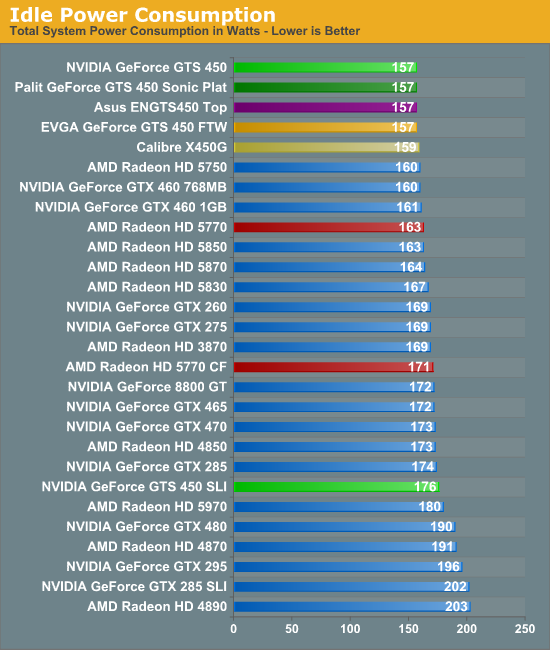
NVIDIA does not provide an official idle TDP, however it’s very clear that it must be very low. All of our GTS 450 cards bring in the lowest idle power consumption levels on this chart. We know the 5750 is rated for 16W at idle, so it’s safe to assume that the GTS 450 can beat that. Given the extremely low idle clocks of the GTS 450 (50MHz core, 270MHz memory) there’s a good chance this is the reason for the impressive idle power consumption.
We haven’t talked about SLI/CF much, but it bears mentioning here. NVIDIA doesn’t have an equivalent of AMD’s Ultra Low Power State for slave cards, which is why the GTS 450 can beat the 5770 as a single card, but lose in SLI/CF.
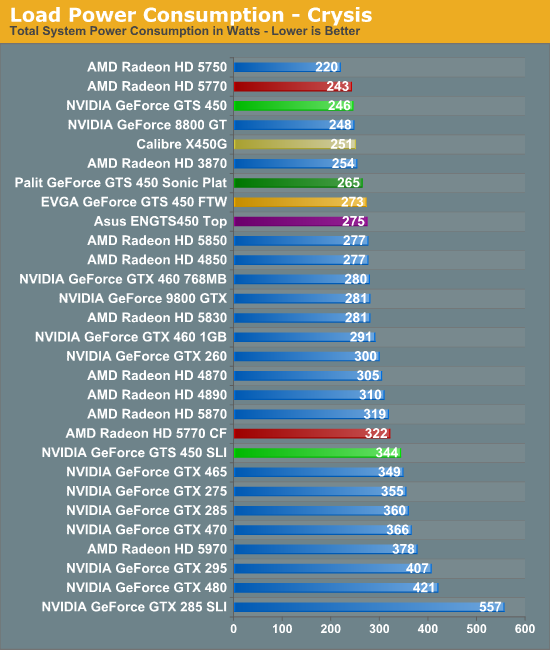

Under load the GTS 450 allows for some very low system power consumption numbers, however it can’t best the 5770. GF106 is a bigger die with more transistors so it’s not surprising that NVIDIA ends up drawing a bit more power here. But their performance also isn’t usually on par with the 5770, so they aren’t in a position to match AMD’s solid performance-per-watt. The overclocked cards do worse here of course, the worst of which is approaching 5850 power levels (and a testament to the 5850’s capabilities).
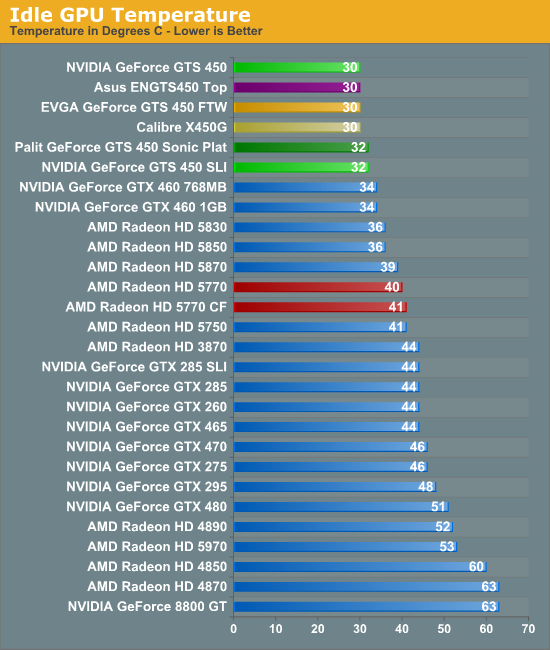
Along with giving us some of the lowest idle power numbers we’ve seen for a mainstream card, the GTS 450 also gives us the coolest temperatures. Even the GTX 460 can’t compete with the GTS 450, whose GPU barely breaks room temperature with the reference card. It’s also one of the few things the Radeon 5700 series is decidedly worse at, with the coolest of those cards getting up to 40C.
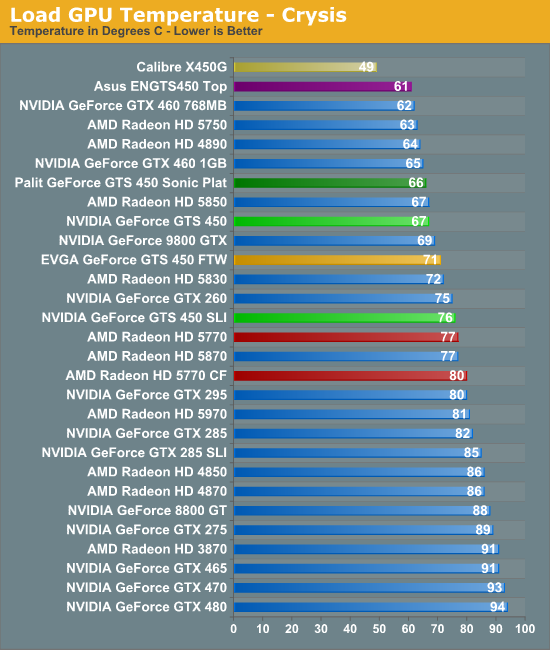

We’ll get to the Calibre card in our companion article focusing on the vendor cards, but for now we’ll stick to the reference and reference-like cards. The GTS 450 represents NVIDIA’s continued use of aggressive cooling. With a smaller all-aluminum heatsink it can’t hope to match the GTX 460, but at the same time it’s a good 10C ahead of the 5770 when it comes to Crysis. Even under Furmark the factory overclocked cards still only reach 5770 temperatures, showcasing just how good the cooling on these cards is.
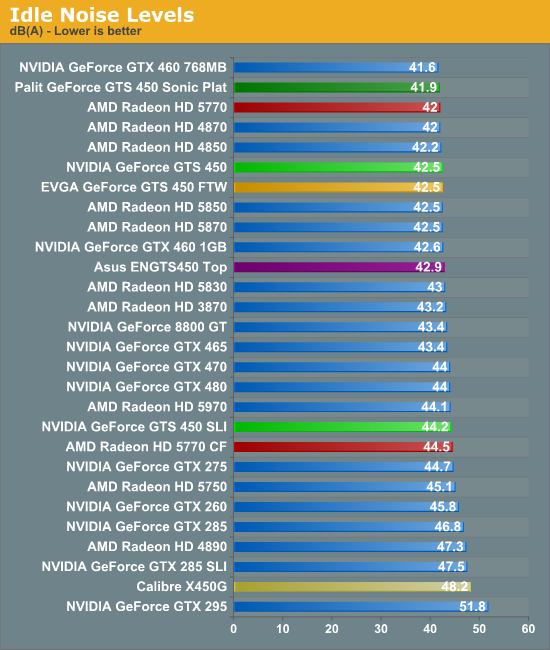
As always, the amount of noise generated at idle for a good card should be indistinguishable from other cards. The GTS 450 is no exception, generating around 42 dB(A) as we’ve come to expect.

Traditional wisdom for a video card is that if you have (relatively) high power draw you can either have a cool card or a quiet card but not both. The GTS 450 breaks the idiom wide-open – we’ve already established it draws more power than the 5770, and yet our reference card barely breaks the noise floor. At 43.3dB(A) it’s effectively silent, a feat not even the GTX 460 or the 5770 can claim. If you can ventilate your case at similarly quiet levels (necessary by fact that the GTS 450 exhausts some hot air in to the case) then we’re certainly looking at a contender for one of the most balanced HTPC cards ever.
Quickly, SLI is a bit of a different story. The reference design is great for a single card, but having two of such cards right next to each other truly suffocates the first card. We’ve said it once and we’ll say it again: if you can separate your Fermi cards, it’s in your best interest to do so.










66 Comments
View All Comments
just4U - Monday, September 13, 2010 - link
Here in Canada I haven't really seen any 5850's priced under 300 yet and most are up in the 330 range.. The 1G 460 sit's in the 220-240 (no price drops for us) so it's a tempting alternative for many (I think)I also believe the 5850 will be a $200 card sometime in the near future. It's been selling way above it's suggested retail price (at launch) and when that happens it will be harder to consider the 460 as a viable alternative. I can't see it being sold at $150 (for the 1G variants) any time soon... so only fan's of Nvidia would consider it if it's priced in the 5850s range.
jabber - Monday, September 13, 2010 - link
Big thing is...who actually bought a 5830?When it came out everyone said it was a pointless card so big whoop, Nvidia's 460 beats a card that should never have been released in the first place.
Bit like saying "our car out performed the Ford Edsel!"
If you want middle of the road performance you get a 5770, if you want a better boost you get the 5850.
just4U - Monday, September 13, 2010 - link
It was only a pointless card because of it's price... Originally it should have been alot cheaper but supply and demand has inflated the prices of most of Amd's 5X lineup. Sitting near a $100 more then the 5770 is what made it a hard sell.erple2 - Wednesday, September 15, 2010 - link
Sure it did - the 768MB version fo the 460 now gave you 5830 performance for > 10% less money. To me, that makes it sound like the 5830 was now "obsoleted" by the 460 series. The 1 GB card was significantly faster at the same price point, and the 768 MB version was just as fast, but significantly cheaper. Both using less power, noise and heat.Isn't that essentially what defines "obsoletes"?
SandmanWN - Monday, September 13, 2010 - link
Throughout the entire test suite the 5850 is within 4-6 frames of the 470. In two it makes it to 8 and 10 frames more. Given you need an extra 100W's on your power supply and the additional cost associated with that just to get that tiny fraction of output, the statement seems fanboyish. AT should be better than this.just4U - Monday, September 13, 2010 - link
What does the 470 have to do with this? Most of us all agree that the 465/470/480 are all heat scores with insane power draws.. the 460 addressed that and came in at a price point that hit a sweet spot.. bringing alot of the 470/480's strengths and none of it's weaknesses to the table. Only real complaint I've seen for the 460 is the mini hdmi.IceDread - Tuesday, September 14, 2010 - link
You are missing my point.By saying "and it struck beautifully" implies that you are cheering for the nvidia team. It would be a different thing if he wrote "and it struck hard" or something like that.
adonn78 - Monday, September 13, 2010 - link
I read another review, damn my cheating heart. That stated the SLI scalling ont hese cards were impressive. You got 2 GTS 450 cards but no SLI?Stuka87 - Monday, September 13, 2010 - link
Er, every single benchmark shows the GTS-450 SLI scores. They are marked in green (like the regular GTS-450).marraco - Monday, September 13, 2010 - link
Other web sites show that the 450 is slower than the 250.It's strange when the 250 has 128 shaders, and the 450 has 192.... and the 450 has DDR5 vs DDR3 in the 250.
It looks like the texture units bottleneck this design.
Even more strange is that I could not find the 250 on this article charts.
I don't see the 450 as price competitive with the radeons, except as SLI setup. It would be more valuable if 3-SLI way were allowed, and I guess that is not the case, because the photos shown only a single SLI connector.
The SLI setups are unbeatable against the radeons price/performance. Maybe nVidia should design cheap, energy-efficient chips so a card manufacturer can pack 10 video chips on a single card.